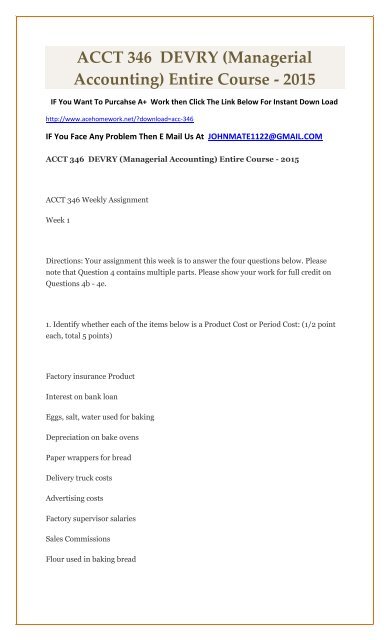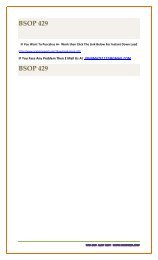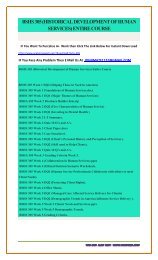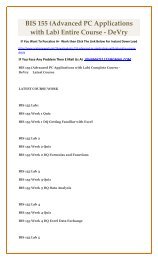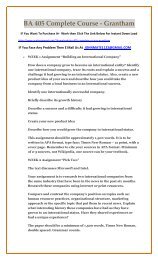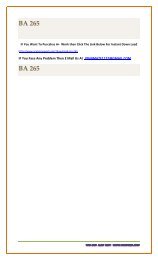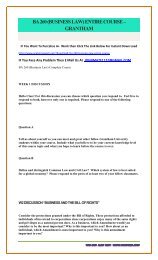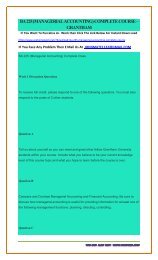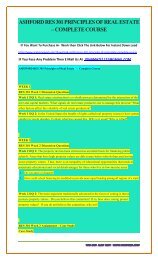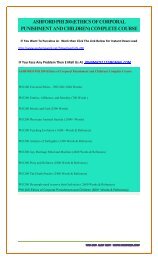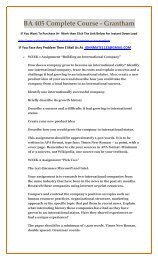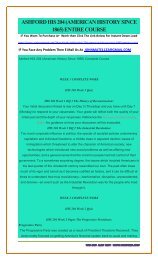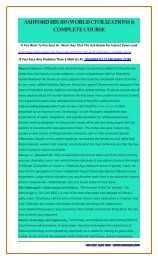ACCT 346 DEVRY (Managerial Accounting) Entire Course - 2015
Create successful ePaper yourself
Turn your PDF publications into a flip-book with our unique Google optimized e-Paper software.
<strong>ACCT</strong> <strong>346</strong> <strong>DEVRY</strong> (<strong>Managerial</strong><br />
<strong>Accounting</strong>) <strong>Entire</strong> <strong>Course</strong> - <strong>2015</strong><br />
IF You Want To Purcahse A+ Work then Click The Link Below For Instant Down Load<br />
http://www.acehomework.net/?download=acc-<strong>346</strong><br />
IF You Face Any Problem Then E Mail Us At JOHNMATE1122@GMAIL.COM<br />
<strong>ACCT</strong> <strong>346</strong> <strong>DEVRY</strong> (<strong>Managerial</strong> <strong>Accounting</strong>) <strong>Entire</strong> <strong>Course</strong> - <strong>2015</strong><br />
<strong>ACCT</strong> <strong>346</strong> Weekly Assignment<br />
Week 1<br />
Directions: Your assignment this week is to answer the four questions below. Please<br />
note that Question 4 contains multiple parts. Please show your work for full credit on<br />
Questions 4b - 4e.<br />
1. Identify whether each of the items below is a Product Cost or Period Cost: (1/2 point<br />
each, total 5 points)<br />
Factory insurance Product<br />
Interest on bank loan<br />
Eggs, salt, water used for baking<br />
Depreciation on bake ovens<br />
Paper wrappers for bread<br />
Delivery truck costs<br />
Advertising costs<br />
Factory supervisor salaries<br />
Sales Commissions<br />
Flour used in baking bread
2. Identify whether each of the items below is a Direct Cost or Indirect Cost: (1/2 point<br />
each, total 5 points)<br />
Factory insurance Indirect<br />
Baker's wages<br />
Eggs used for baking<br />
Depreciation on bake ovens<br />
Paper wrappers for bread<br />
Cleaning materials for bake ovens<br />
Utilities used in factory<br />
Factory supervisor salaries<br />
Small amount of salt used<br />
Flour used in baking bread<br />
3. Identify whether each of the below is a Fixed Cost or Variable Cost: (1/2 point each,<br />
total 5 points)<br />
Shipping costs for bread Variable<br />
Cost of fuel for delivery truck<br />
Factory rent<br />
Factory insurance<br />
Maintenance on delivery truck<br />
Sales commissions<br />
Hourly wages paid to baker's assistant<br />
Oven depreciation<br />
Cost of fruit for cake topping<br />
Factory utilities
4. Classify each as direct material, direct labor, indirect labor, indirect labor, other<br />
manufacturing overhead or period cost, and then answer the 5 questions below: 4a.<br />
Classify each cost (the first one is done for you): (5 points total)<br />
An airline manufacturer incurred the following costs last month (in thousands of<br />
dollars): Direct Material Direct Labor Indirect Material Indirect Labor Other<br />
Manufacturing Overhead Period Cost<br />
a. Depreciation on forklifts ........................................................................... $60 $60<br />
b. Property tax on corporate marketing office ............................................. $30<br />
c. Cost of warranty repairs ............................................................................ $220<br />
d. Factory janitors’ wages ............................................................................. $10<br />
e. Cost of designing new plant layout .......................................................... $190<br />
f. Machine operators’ health insurance ....................................................... $40<br />
g. Airplane seats ........................................................................................... $270<br />
h. Depreciation on administrative offices ..................................................... $70<br />
i. Assembly workers’ wages ......................................................................... $670<br />
j. Plant utilities ............................................................................................. $110<br />
k. Production supervisors’ salaries ................................................................ $160<br />
l. Jet engines ................................................................................................ $1,100<br />
m. Machine lubricants .................................................................................... $20<br />
Then, answer the below questions:<br />
4b. How much are total manufacturing overhead costs? (5 points)<br />
4c. How much are total inventoriable product costs? (5 points)<br />
4d. How much are total prime costs? (5 points)<br />
4e. How much are total conversion costs? (5 points)<br />
DeVry University
<strong>ACCT</strong><strong>346</strong> Weekly Assignment<br />
Week 2<br />
Directions: Your assignment this week is to answer the three questions below. Please<br />
note that Question #3 has 2 parts, Part A and Part B. Please show your work for full<br />
credit and use the box provided. Please add more rows or columns to the box if needed.<br />
1. Biltz Company uses a predetermined overhead rate based on direct labor hours to<br />
allocate manufacturing overhead to jobs. During the year, the company actually<br />
incurred manufacturing overhead costs of $582,000 and 135,000 direct labor hours<br />
were worked. The company estimated that it would incur $525,000 of manufacturing<br />
overhead during the year and that 150,000 direct labor hours would be worked.<br />
By how much was manufacturing overhead overallocated or underallocated for the year?<br />
2. The following account balances at the beginning of January were selected from the<br />
general ledger of Ocean City Manufacturing Company:<br />
Work-in-process inventory $0<br />
Raw materials inventory $28,000<br />
Finished goods inventory $40,000<br />
Additional data:<br />
1) Actual manufacturing overhead for January amounted to $62,000.<br />
2) Total direct labor cost for January was $63,000.<br />
3) The predetermined manufacturing overhead rate is based on direct labor cost. The<br />
budget for the year called for $250,000 of direct labor cost and $350,000 of<br />
manufacturing overhead costs.
4) The only job unfinished on January 31 was Job No. 151, for which total direct labor<br />
charges were $5,200 (800 direct labor hours) and total direct material charges were<br />
$14,000.<br />
5) Cost of direct materials placed in production during January totaled $123,000. There<br />
were no indirect material requisitions during January.<br />
6) January 31 balance in raw materials inventory was $35,000.<br />
7) Finished goods inventory balance on January 31 was $34,500.<br />
What is the cost of goods manufactured for January? Show your work for full credit.<br />
3. Vintage Fun reproduces old-fashioned style roller skates and skateboards. The annual<br />
production and sales of roller skates is 950 units, while 1,750 skateboards are produced<br />
and sold. The company has traditionally used direct labor hours to allocate its overhead<br />
to products. Roller skates require 2.5 direct labor hours per unit, while skateboards<br />
require 1.25 direct labor hours per unit. The total estimated overhead for the period is<br />
$114,300. The company is looking at the possibility of changing to an activity-based<br />
costing system for its products. If the company used an activity-based costing system, it<br />
would have the following three activity cost pools:<br />
3a. What is the predetermined overhead allocation rate using the traditional costing<br />
system?<br />
3b. What is the overhead cost per skateboard using an activity-based costing system?<br />
week 3<br />
<strong>ACCT</strong><strong>346</strong>
Weekly Assignment<br />
Week 3<br />
Directions: Your assignment this week is to answer the two questions below. Please note<br />
that Question #2 has 2 parts, Part A and Part B. Please show your work for full credit<br />
and use the box provided. Please add more rows or columns to the box if needed.<br />
1. Beginning WIP inventory is 15,500 units, 75% complete for materials. During the<br />
month, 90,000 units were started; 87,000 were finished; and ending WIP was 18,500<br />
units that were 50% complete for materials.<br />
How many equivalent units should be used to allocate costs for materials? (Assume that<br />
the weighted average method is used, not FIFO.)<br />
2. During a period, 38,200 units were completed and 4,200 units were in ending WIP<br />
inventory. Ending WIP was 75% complete for direct materials and 50% complete for<br />
conversion costs.<br />
2a. What are the equivalent units for direct materials?<br />
2b. What are the equivalent units for conversion costs?<br />
week 4<br />
DeVryDeVry University
<strong>ACCT</strong><strong>346</strong> Weekly Assignment<br />
Week 5<br />
Directions: Your assignment this week is to answer the below three questions. Please<br />
note that question #1 has 2 parts, part a and part b and question #2 has 3 parts, part a,<br />
part b and part c. Please show your work for full credit and use the box provided. Please<br />
add more rows or columns to the box if needed.<br />
1. Palmer's Gourmet Chocolates produces and sells assorted boxed chocolates. The unit<br />
selling price is $50, unit variable costs are $25, and total fixed costs are $2,000.<br />
1a. How many boxes of chocolates must Palmer's Gourmet Chocolates sell to breakeven?<br />
1b. What are breakeven sales in dollars?<br />
2. Extreme Sports received a special order for 1,000 units of its extreme motorbike at a<br />
selling price of $250 per motorbike. Extreme Sports has enough extra capacity to accept<br />
the order. No additional selling costs will be incurred. Unit costs to make and sell this<br />
product are as follows: Direct materials, $100; direct labor, $50; variable manufacturing<br />
overhead, $14; fixed manufacturing overhead, $10, and variable selling costs, $2.<br />
2a. List the relevant costs.<br />
2b. What will be the change in operating income if Extreme Sports accepts the special<br />
order?
2c. Should Extreme Sports accept the special order? Why or why not?<br />
3. Totally Technology manufactures Cameras and Video Recorders. The company's<br />
product line income statement follows:<br />
Camera Video Recorder Total<br />
Sales revenue $3,00,000 $1,00,000 $4,00,000<br />
Cost of goods sold<br />
Variable $75,000 $49,000 $1,24,000<br />
Fixed $82,000 $28,000 $1,10,000<br />
Total cost of goods sold $1,57,000 $77,000 $2,34,000<br />
Gross profit $1,43,000 $23,000 $1,66,000<br />
Marketing and administrative expenses<br />
Variable $25,000 $28,000 $53,000<br />
Fixed $32,000 $19,000 $51,000<br />
Total marketing and administrative expenses $57,000 $47,000 $1,04,000<br />
Operating income (loss) $86,000 (24,000) $62,000<br />
Management is considering discontinuing the Video Recorder product line. Accountants<br />
for the company estimate that discontinuing the Video Recorder line will decrease fixed<br />
cost of goods sold by $10,000 and fixed marketing and administrative expenses by<br />
$4,000.<br />
Prepare an analysis supporting your opinion about whether or not the Video Recorder<br />
product line should be discontinued.<br />
UniversiDeVry University
<strong>ACCT</strong><strong>346</strong> Weekly Assignment<br />
Week 6<br />
Directions: Your assignment this week is to answer the two questions below. Please note<br />
that Question #2 has 2 parts, Part A and Part B. Please show your work for full credit<br />
and use the box provided. Please add more rows or columns to the box if needed.<br />
1. Cave Hardware's forecasted sales for April, May, June, and July are $200,000,<br />
$230,000, $190,000, and $240,000, respectively. Sales are 65% cash and 35% credit<br />
with all accounts receivables collected in the month following the sale. Cost of goods<br />
sold is 75% of sales and ending inventory is maintained at $60,000 plus 10% of the<br />
following month's cost of goods sold. All inventory purchases are paid 22% in the month<br />
of purchase and 78% in the following month.<br />
What are the cash collections budgeted for June?<br />
2. Madden Corporation manufactures t-shirts, which is its only product. The standards<br />
for t-shirts are as follows:<br />
Standard direct labor cost per hour $17<br />
Standard direct labor hours per t-shirt 0.6<br />
During the month of January, the company produced 1,250 t-shirts. Related production<br />
data for the month is as follows:<br />
Actual direct labor hours 770<br />
Actual direct labor cost incurred $13,000
2a. What is the direct labor rate variance for the month? Is it favorable or unfavorable?<br />
2b. What is the direct labor efficiency variance for the month? Is it favorable or<br />
unfavorable?<br />
ty<br />
<strong>ACCT</strong><strong>346</strong> Weekly Assignment<br />
Week 4<br />
Directions: Your assignment this week is to answer the question below which has four<br />
parts. Please show your work for full credit and use the boxes provided. Please add more<br />
rows or columns to the box if needed.<br />
1. MountainAir Company has the following selected data for the past year:<br />
Units sold during year 30,000<br />
Units produced during year 45,000<br />
Units in ending inventory 15,000<br />
Variable manufacturing cost per unit $4.50<br />
Fixed manufacturing overhead (in total) $20,250<br />
Selling price per unit $12.00<br />
Variable selling and administrative expense per unit $1.00<br />
Fixed selling and administrative expenses (in total) $4,000<br />
There were no units in beginning inventory.<br />
Required:
1a. Prepare an income statement for last year using absorption costing.<br />
1b. Calculate the value of the ending inventory using absorption costing.<br />
1c. Prepare an income statement for last year using variable costing.<br />
1d. Calculate the value of the ending inventory using variable costing.<br />
week 6<br />
DeVry University<br />
<strong>ACCT</strong><strong>346</strong> Weekly Assignment<br />
Week 6<br />
Directions: Your assignment this week is to answer the two questions below. Please note<br />
that Question #2 has 2 parts, Part A and Part B. Please show your work for full credit<br />
and use the box provided. Please add more rows or columns to the box if needed.<br />
1. Cave Hardware's forecasted sales for April, May, June, and July are $200,000,<br />
$230,000, $190,000, and $240,000, respectively. Sales are 65% cash and 35% credit<br />
with all accounts receivables collected in the month following the sale. Cost of goods<br />
sold is 75% of sales and ending inventory is maintained at $60,000 plus 10% of the<br />
following month's cost of goods sold. All inventory purchases are paid 22% in the month<br />
of purchase and 78% in the following month.<br />
What are the cash collections budgeted for June?
2. Madden Corporation manufactures t-shirts, which is its only product. The standards<br />
for t-shirts are as follows:<br />
Standard direct labor cost per hour $17<br />
Standard direct labor hours per t-shirt 0.6<br />
During the month of January, the company produced 1,250 t-shirts. Related production<br />
data for the month is as follows:<br />
Actual direct labor hours 770<br />
Actual direct labor cost incurred $13,000<br />
2a. What is the direct labor rate variance for the month? Is it favorable or unfavorable?<br />
2b. What is the direct labor efficiency variance for the month? Is it favorable or<br />
unfavorable?<br />
week 7<br />
DeVry University<br />
<strong>ACCT</strong><strong>346</strong> Weekly Assignment
Week 7<br />
Directions: Your assignment this week is to answer the four questions below. Please<br />
note that Question #1 has 2 parts, Part A and Part B. Please show your work for full<br />
credit and use the box provided. Please add more rows or columns to the box if needed.<br />
1. Gomez Corporation is considering two alternative investment proposals with the<br />
following data:<br />
Proposal X Proposal Y<br />
Investment $8,50,000 $4,68,000<br />
Useful life 8 years 8 years<br />
Estimated annual net $1,25,000 $78,000<br />
cash inflows for 8 years<br />
Residual value $40,000 $ -<br />
Depreciation method Straight-line Straight-line<br />
Required rate of return 14% 10%<br />
1a. How long is the payback period for Proposal X?<br />
1b. What is the accounting rate of return for Proposal Y?<br />
2. You have been awarded a scholarship that will pay you $500 per semester at the end<br />
of each of the next 8 semesters that you earn a GPA of 3.5 or better. You are a very<br />
serious student and you anticipate receiving the scholarship every semester. Using a<br />
discount rate of 3% per semester, which of the following is the correct calculation for
determining the present value of the scholarship? PLEASE STATE WHY YOU CHOSE<br />
THE ANSWER THAT YOU DID.<br />
A) PV = $500 × 3% × 8<br />
B) PV = $500 × (Annuity PV factor, i = 3%, n = 8)<br />
C) PV = $500 × (Annuity FV factor, i = 6%, n = 4)<br />
D) PV = $1,000 × (PV factor, i = 3%, n = 4)<br />
3. Maersk Metal Stamping is analyzing a special investment project. The project will<br />
require the purchase of two machines for $30,000 and $8,000 (both machines are<br />
required). The total residual value at the end of the project is $1,500. The project will<br />
generate cash inflows of $11,000 per year over its 8-year life.<br />
If Maersk requires a 6% return, what is the net present value (NPV) of this project? (Use<br />
present value tables or Excel.)<br />
4. Hincapie Manufacturing is evaluating investing in a new metal stamping machine<br />
costing $30,924. Hincapie estimates that it will realize $12,000 in annual cash inflows<br />
for each year of the machine's 3-year useful life.<br />
Approximately, what is the the internal rate of return (IRR) for the machine? (Use<br />
present value tables or Excel.<br />
<strong>ACCT</strong> <strong>346</strong> All Discussions - Latest <strong>2015</strong><br />
<strong>ACCT</strong> <strong>346</strong> Week 1 DQ 1 Ethics and Ethical Behavior<br />
<strong>ACCT</strong> <strong>346</strong> Week 1 DQ 2 <strong>Managerial</strong> and Financial <strong>Accounting</strong><br />
<strong>ACCT</strong> <strong>346</strong> Week 2 DQ 1 Job-Order Costing<br />
<strong>ACCT</strong> <strong>346</strong> Week 2 DQ 2 Process Costing
<strong>ACCT</strong> <strong>346</strong> Week 3 DQ 1 Cost-Volume-Profit Analysis<br />
<strong>ACCT</strong> <strong>346</strong> Week 3 DQ 2 Variable Costing and Full Costing<br />
<strong>ACCT</strong> <strong>346</strong> Week 4 DQ 1 Activity-Based Costing<br />
<strong>ACCT</strong> <strong>346</strong> Week 4 DQ 2 Incremental Cost Analysis<br />
<strong>ACCT</strong> <strong>346</strong> Week 5 DQ 1 Pricing Techniques<br />
<strong>ACCT</strong> <strong>346</strong> Week 5 DQ 2 Capital Budgeting Techniques<br />
<strong>ACCT</strong> <strong>346</strong> Week 6 DQ 1 Budgeting<br />
<strong>ACCT</strong> <strong>346</strong> Week 6 DQ 2 Standard Costs and Variance Analysis<br />
<strong>ACCT</strong> <strong>346</strong> Week 7 DQ 1 Responsibility Centers<br />
<strong>ACCT</strong> <strong>346</strong> Week 7 DQ 2 Financial Statement Analysis<br />
<strong>ACCT</strong> <strong>346</strong> Project Bravo Baking Company<br />
<strong>ACCT</strong> <strong>346</strong> Quiz Week 3<br />
<strong>ACCT</strong> <strong>346</strong> Quiz Week 6<br />
<strong>ACCT</strong> <strong>346</strong> Midterm New-Updated<br />
<strong>ACCT</strong> <strong>346</strong> Final Exam - LATEST<br />
Question 1.1. (TCO 1) How does managerial and financial accounting differ<br />
in terms of the amount of detail presented and nonmonetary and monetary<br />
information? (Points : 15)
Question 2.2. (TCO 2) What is an indirect labor cost? What is an example of<br />
an indirect labor cost? (Points : 15)<br />
Question 3.3. (TCO 3) What is the difference between job order and process<br />
costing? (Points : 15)<br />
Question 4.4. (TCO 4) What is a fixed cost? What is an example of a fixed<br />
cost? (Points : 15)<br />
Question 1.1. (TCO 5) What is full costing? How does it differ from variable<br />
costing? (Points : 15)<br />
Question 2.2. (TCO 6) What is the first step in the cost allocation process?<br />
What is done in this step? (Points : 15)<br />
Question 3.3. (TCO 7) What is an incremental cost? What is an example of<br />
one? (Points : 15)<br />
Question 4.4. (TCO 8) What is activity-based pricing? How is the price<br />
determined? (Points : 15)<br />
Question 1.1. (TCO 6) Name the steps in the ABC approach. Describe each<br />
of them. Which do you think is the most important step? Why? (Points : 30)<br />
Question 2.2. (TCO 7) Products Kappa and Sigma are joint products. The<br />
joint production cost of the products is $800. Kappa has a market value of<br />
$450 at the split-off point. If Kappa is further processed at an additional<br />
cost of $600, its market value is $1,400. Product Sigma has a market value<br />
of $1,150 at the split-off point. If Product Sigma is further processed at an<br />
additional cost of $300, its market value is $1,400. Using the relative sales<br />
value method, calculate the joint product cost that would be allocated to<br />
Kappa and Sigma. How do you know if one of the products should be<br />
further processed?<br />
(Points : 30)
Question 3.3. (TCO 8) A company must incur annual fixed costs of<br />
$4,000,000 and variable costs of $400 per unit and estimates that it can<br />
sell 40,000 pumps annually and marks up cost by 30 percent. Using costplus<br />
pricing, what is the cost per unit and the price? What are advantages<br />
and disadvantages of cost-plus pricing?(Points : 30)<br />
Question 1.1. (TCO 9) A project will require an initial investment of<br />
$250,000 and will return $50,000 each year for seven years. If taxes are<br />
ignored and the required rate of return is 9%, what is the project's net<br />
present value? Based on this analysis, should the company proceed with the<br />
project? (Points : 30)<br />
Question 2.2. (TCO 10) Why does a company perform ratio analysis? What<br />
are the debt-related ratios? Describe the formula for one debt-related ratio<br />
and explain how to interpret the ratio. (Points : 30)<br />
Question 1. Question :<br />
(TCO 1) Who are the users of managerial accounting<br />
information? How does their use of accounting information<br />
differ from the users of financial accounting information?<br />
(TCO 2) What is an indirect labor cost? What is an example of an indirect<br />
labor cost?<br />
TCO 3) What is job-order costing? What type of company would us joborder<br />
costing?<br />
(TCO 4) What is a variable cost? What is an example of a variable cost?<br />
(TCO 5) What is full costing? How does it differ from variable costing?
(TCO 6) Explain why companies might choose to allocate the costs of their service<br />
departments (ie. Human Resources, Maintenance, Mailroom, etc...) to their production<br />
departments. Also describe some typical bases companies use to base their allocations<br />
on. Last, what should a company be mindful of when analyzing the profitability of<br />
segments that have allocated costs.<br />
(TCO 7) What is an incremental cost? What is an example of one?<br />
(TCO 8) What is cost plus pricing? How does the company determine the profit level?<br />
Gina's Boutique makes custom jewelry. One item, the guru necklace, is a best seller and<br />
sales in units for the first quarter are as follows:<br />
Acme Fireworks uses a traditional overhead allocation based on direct labor hours. For<br />
the current year overhead is estimated at $1,000,000 and direct labor hours are budgeted at<br />
200,000 hours. Actual hours worked were 195,000 and actual overhead was $978,000.<br />
Question :<br />
(TCO 9) A project will require an initial investment of<br />
$300,000 and will return $75,000 each year for eight years. If<br />
taxes are ignored and the required rate of return is 9%, what is<br />
the project's net present value? Based on this analysis, should<br />
the company proceed with the project?


